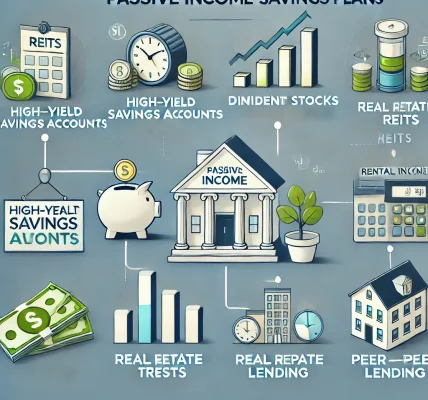Introduction
In an era where financial stability is more important than ever, high-interest savings accounts (HISAs) have gained popularity as a smart savings option. These accounts promise better interest rates than regular savings accounts, making them attractive for individuals looking to grow their savings safely. But are they really worth it?
This guide explores the pros and cons of high-interest savings accounts, how they compare to other savings options, and whether they are the right choice for your financial goals.
What is a High-Interest Savings Account?
A high-interest savings account is a type of savings account that offers a higher interest rate compared to standard savings accounts. These accounts are typically offered by banks, credit unions, and online financial institutions, allowing savers to earn more on their deposits while maintaining liquidity.
Features of High-Interest Savings Accounts:
- Higher Interest Rates: Typically offer better returns than traditional savings accounts.
- Liquidity: Funds can be accessed anytime without penalties (in most cases).
- Low Risk: Unlike investments, these accounts are usually insured by government deposit insurance schemes.
- Flexible Deposits: You can add or withdraw money as needed (though some banks may impose limits).
Benefits of High-Interest Savings Accounts
1. Higher Returns on Savings
The primary advantage of HISAs is their higher interest rate, which means your money grows faster than in a regular savings account. While rates vary by institution, they generally provide a better return than standard accounts.
2. Low Risk and Security
Unlike stocks or mutual funds, high-interest savings accounts are a safe option for risk-averse individuals. Many countries have government-backed insurance (such as FDIC in the U.S. or FSCS in the U.K.), which protects deposits up to a certain limit.
3. Easy Accessibility
Unlike fixed deposits (FDs) or other locked savings instruments, HISAs allow you to withdraw funds anytime without penalties, making them ideal for emergency savings.
4. No or Low Fees
Many banks offer high-interest savings accounts with no monthly fees or minimum balance requirements, making them a cost-effective way to save.
5. Ideal for Short-Term Goals
If you’re saving for a vacation, home down payment, or emergency fund, HISAs provide a safe place to park your money while earning a return.
Drawbacks of High-Interest Savings Accounts
1. Interest Rates Can Fluctuate
Unlike fixed deposits, HISAs usually have variable interest rates, meaning banks can reduce the rate anytime based on market conditions.
2. Inflation Can Reduce Purchasing Power
While HISAs provide a safe return, the interest rate may not always keep up with inflation, which means your savings could lose real value over time.
3. Transaction Limits
Some banks impose limits on withdrawals per month. Exceeding the limit may result in fees or reduced interest earnings.
4. Not Ideal for Long-Term Growth
While HISAs are great for short-term savings, they don’t offer the same potential returns as stocks, mutual funds, or other investment options over the long term.
How Do High-Interest Savings Accounts Compare to Other Options?
| Feature | High-Interest Savings Account | Fixed Deposit (FD) | Stock Market | Mutual Funds |
|---|---|---|---|---|
| Risk | Low | Low | High | Medium to High |
| Interest Rate | Moderate (Variable) | Higher (Fixed) | High (Uncertain) | Medium to High |
| Liquidity | High | Low (Penalty for early withdrawal) | High | Medium |
| Best For | Short-Term Savings, Emergency Fund | Long-Term Guaranteed Savings | Long-Term Growth | Balanced Growth |
Who Should Use a High-Interest Savings Account?
1. Individuals Building an Emergency Fund
HISAs are perfect for an emergency fund, allowing quick access while earning some interest.
2. Short-Term Savers
If you are saving for a vacation, wedding, or home renovation, HISAs provide a safe place to grow your funds.
3. People Looking for a Low-Risk Option
For risk-averse individuals who don’t want to invest in volatile assets, HISAs offer a safe and steady way to earn returns.
Tips for Choosing the Best High-Interest Savings Account
1. Compare Interest Rates
Check the rates offered by different banks and financial institutions to find the best option.
2. Check for Hidden Fees
Some accounts have monthly maintenance fees or transaction fees that can reduce your earnings. Choose one with minimal or no fees.
3. Look at Withdrawal Limits
Ensure the account allows sufficient monthly withdrawals based on your needs.
4. Read the Fine Print
Some banks offer promotional rates that drop after a few months. Read the terms to avoid surprises.
5. Consider Online Banks
Online banks often offer higher interest rates due to lower overhead costs compared to traditional banks.
Are High-Interest Savings Accounts Worth It?
Yes, If You:
✅ Need a safe place to store your money with minimal risk.
✅ Want an accessible account for emergencies or short-term savings.
✅ Prefer a low-risk, hassle-free savings option.
✅ Want steady but moderate returns without market volatility.
No, If You:
❌ Are looking for higher long-term returns (consider stocks or mutual funds instead).
❌ Need fixed interest rates (consider Fixed Deposits).
❌ Don’t mind some risk in exchange for potential higher investment gains.
Conclusion
High-interest savings accounts are a valuable financial tool for individuals looking to grow their savings while keeping funds accessible. While they may not provide the highest returns, their security, liquidity, and low risk make them an excellent choice for emergency funds and short-term goals.
Before opening a HISA, compare interest rates, fees, and terms to ensure you get the best deal. If your goal is long-term wealth creation, consider diversifying into stocks, bonds, or other investment vehicles alongside your savings account.
Final Tip:
If you are new to savings and want a simple, risk-free way to earn extra money on your deposits, a high-interest savings account can be a great starting point. Choose wisely and make the most of your savings!




